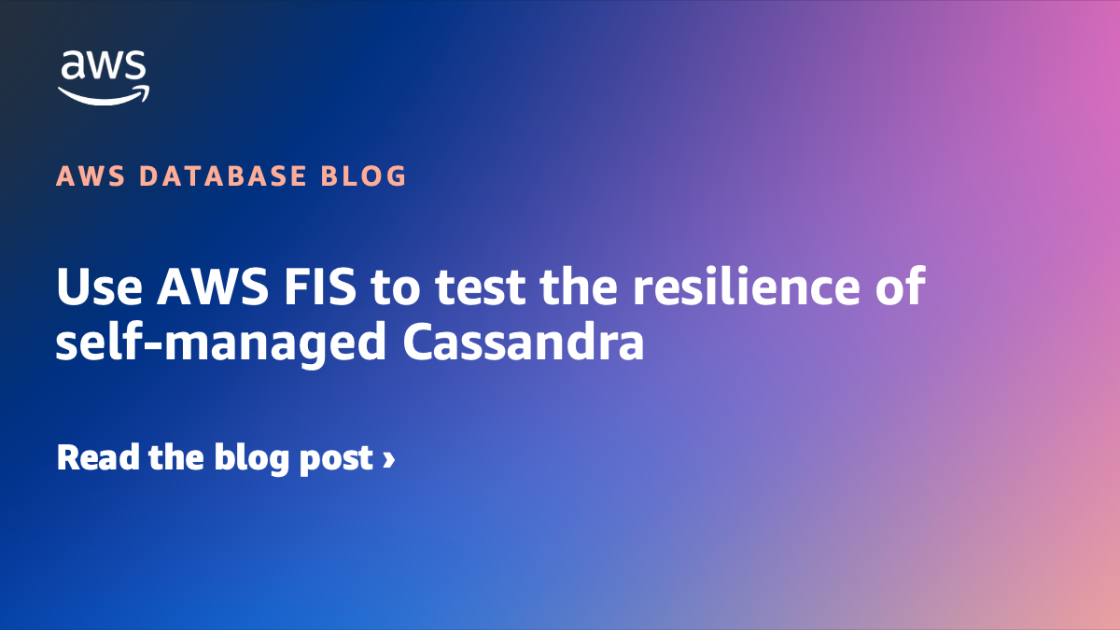aws.amazon.com/blogs/database/use-aws-fis-to-test-the-resilience-of-self-managed-cassandra
Preview meta tags from the aws.amazon.com website.
Linked Hostnames
17- 63 links toaws.amazon.com
- 4 links towww.linkedin.com
- 3 links tocassandra.apache.org
- 2 links todocs.aws.amazon.com
- 2 links topages.awscloud.com
- 2 links toportal.aws.amazon.com
- 2 links torepost.aws
- 2 links totwitter.com
Thumbnail

Search Engine Appearance
Use AWS FIS to test the resilience of self-managed Cassandra | Amazon Web Services
Database outages can have devastating effects on your applications and business operations. For teams running self-managed Apache Cassandra clusters, unexpected node failures or memory issues can lead to service degradation, data inconsistency, or even complete system outages. AWS Fault Injection Service (AWS FIS) is a managed service that you can use to perform fault injection experiments on your AWS workloads. In this post, we review how you can use AWS FIS to craft a chaos experiment to test the resilience of your self-managed Cassandra clusters running on Amazon EC2. This can help you understand your application’s ability to reestablish a connection to a healthy node.
Bing
Use AWS FIS to test the resilience of self-managed Cassandra | Amazon Web Services
Database outages can have devastating effects on your applications and business operations. For teams running self-managed Apache Cassandra clusters, unexpected node failures or memory issues can lead to service degradation, data inconsistency, or even complete system outages. AWS Fault Injection Service (AWS FIS) is a managed service that you can use to perform fault injection experiments on your AWS workloads. In this post, we review how you can use AWS FIS to craft a chaos experiment to test the resilience of your self-managed Cassandra clusters running on Amazon EC2. This can help you understand your application’s ability to reestablish a connection to a healthy node.
DuckDuckGo
Use AWS FIS to test the resilience of self-managed Cassandra | Amazon Web Services
Database outages can have devastating effects on your applications and business operations. For teams running self-managed Apache Cassandra clusters, unexpected node failures or memory issues can lead to service degradation, data inconsistency, or even complete system outages. AWS Fault Injection Service (AWS FIS) is a managed service that you can use to perform fault injection experiments on your AWS workloads. In this post, we review how you can use AWS FIS to craft a chaos experiment to test the resilience of your self-managed Cassandra clusters running on Amazon EC2. This can help you understand your application’s ability to reestablish a connection to a healthy node.
General Meta Tags
24- titleUse AWS FIS to test the resilience of self-managed Cassandra | AWS Database Blog
- titlefacebook
- titlelinkedin
- titleinstagram
- titletwitch
Open Graph Meta Tags
10og:locale
en_US- og:site_nameAmazon Web Services
- og:titleUse AWS FIS to test the resilience of self-managed Cassandra | Amazon Web Services
- og:typearticle
- og:urlhttps://aws.amazon.com/blogs/database/use-aws-fis-to-test-the-resilience-of-self-managed-cassandra/
Twitter Meta Tags
6- twitter:cardsummary_large_image
- twitter:site@awscloud
- twitter:domainhttps://aws.amazon.com/blogs/
- twitter:titleUse AWS FIS to test the resilience of self-managed Cassandra | Amazon Web Services
- twitter:descriptionDatabase outages can have devastating effects on your applications and business operations. For teams running self-managed Apache Cassandra clusters, unexpected node failures or memory issues can lead to service degradation, data inconsistency, or even complete system outages. AWS Fault Injection Service (AWS FIS) is a managed service that you can use to perform fault injection experiments on your AWS workloads. In this post, we review how you can use AWS FIS to craft a chaos experiment to test the resilience of your self-managed Cassandra clusters running on Amazon EC2. This can help you understand your application’s ability to reestablish a connection to a healthy node.
Link Tags
17- apple-touch-iconhttps://a0.awsstatic.com/main/images/site/touch-icon-iphone-114-smile.png
- apple-touch-iconhttps://a0.awsstatic.com/main/images/site/touch-icon-ipad-144-smile.png
- apple-touch-iconhttps://a0.awsstatic.com/main/images/site/touch-icon-iphone-114-smile.png
- apple-touch-iconhttps://a0.awsstatic.com/main/images/site/touch-icon-ipad-144-smile.png
- canonicalhttps://aws.amazon.com/blogs/database/use-aws-fis-to-test-the-resilience-of-self-managed-cassandra/
Emails
1- ?subject=Use%20AWS%20FIS%20to%20test%20the%20resilience%20of%20self-managed%20Cassandra&body=Use%20AWS%20FIS%20to%20test%20the%20resilience%20of%20self-managed%20Cassandra%0A%0Ahttps://aws.amazon.com/blogs/database/use-aws-fis-to-test-the-resilience-of-self-managed-cassandra/
Links
90- https://aws.amazon.com/?nc2=h_home
- https://aws.amazon.com/accessibility/?nc1=f_cc
- https://aws.amazon.com/architecture/?nc1=f_cc
- https://aws.amazon.com/blogs
- https://aws.amazon.com/blogs/?nc1=f_cc